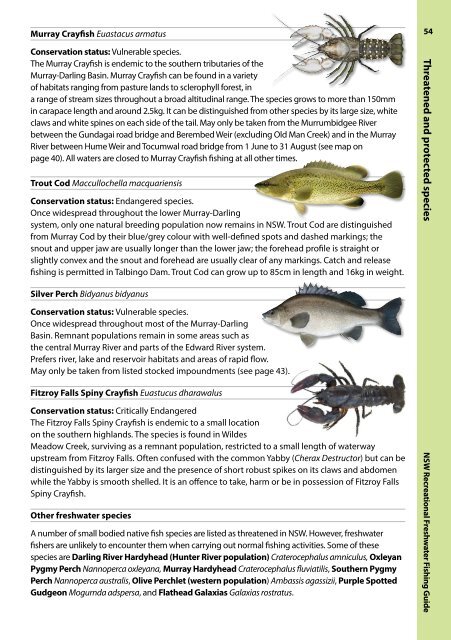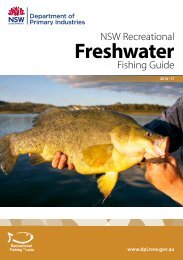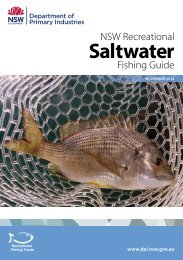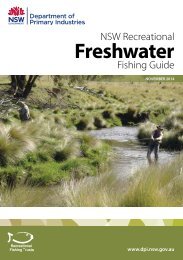freshwater-recreational-fishing-guide-2018-19
Create successful ePaper yourself
Turn your PDF publications into a flip-book with our unique Google optimized e-Paper software.
Murray Crayfish Euastacus armatus<br />
54<br />
Conservation status: Vulnerable species.<br />
The Murray Crayfish is endemic to the southern tributaries of the<br />
Murray-Darling Basin. Murray Crayfish can be found in a variety<br />
of habitats ranging from pasture lands to sclerophyll forest, in<br />
a range of stream sizes throughout a broad altitudinal range. The species grows to more than 150mm<br />
in carapace length and around 2.5kg. It can be distinguished from other species by its large size, white<br />
claws and white spines on each side of the tail. May only be taken from the Murrumbidgee River<br />
between the Gundagai road bridge and Berembed Weir (excluding Old Man Creek) and in the Murray<br />
River between Hume Weir and Tocumwal road bridge from 1 June to 31 August (see map on<br />
page 40). All waters are closed to Murray Crayfish <strong>fishing</strong> at all other times.<br />
Trout Cod Maccullochella macquariensis<br />
Conservation status: Endangered species.<br />
Once widespread throughout the lower Murray-Darling<br />
system, only one natural breeding population now remains in NSW. Trout Cod are distinguished<br />
from Murray Cod by their blue/grey colour with well-defined spots and dashed markings; the<br />
snout and upper jaw are usually longer than the lower jaw; the forehead profile is straight or<br />
slightly convex and the snout and forehead are usually clear of any markings. Catch and release<br />
<strong>fishing</strong> is permitted in Talbingo Dam. Trout Cod can grow up to 85cm in length and 16kg in weight.<br />
Threatened and protected species<br />
Silver Perch Bidyanus bidyanus<br />
Conservation status: Vulnerable species.<br />
Once widespread throughout most of the Murray-Darling<br />
Basin. Remnant populations remain in some areas such as<br />
the central Murray River and parts of the Edward River system.<br />
Prefers river, lake and reservoir habitats and areas of rapid flow.<br />
May only be taken from listed stocked impoundments (see page 43).<br />
Fitzroy Falls Spiny Crayfish Euastucus dharawalus<br />
Conservation status: Critically Endangered<br />
The Fitzroy Falls Spiny Crayfish is endemic to a small location<br />
on the southern highlands. The species is found in Wildes<br />
Meadow Creek, surviving as a remnant population, restricted to a small length of waterway<br />
upstream from Fitzroy Falls. Often confused with the common Yabby (Cherax Destructor) but can be<br />
distinguished by its larger size and the presence of short robust spikes on its claws and abdomen<br />
while the Yabby is smooth shelled. It is an offence to take, harm or be in possession of Fitzroy Falls<br />
Spiny Crayfish.<br />
Other <strong>freshwater</strong> species<br />
A number of small bodied native fish species are listed as threatened in NSW. However, <strong>freshwater</strong><br />
fishers are unlikely to encounter them when carrying out normal <strong>fishing</strong> activities. Some of these<br />
species are Darling River Hardyhead (Hunter River population) Craterocephalus amniculus, Oxleyan<br />
Pygmy Perch Nannoperca oxleyana, Murray Hardyhead Craterocephalus fluviatilis, Southern Pygmy<br />
Perch Nannoperca australis, Olive Perchlet (western population) Ambassis agassizii, Purple Spotted<br />
Gudgeon Mogurnda adspersa, and Flathead Galaxias Galaxias rostratus.<br />
NSW Recreational Freshwater Fishing Guide








